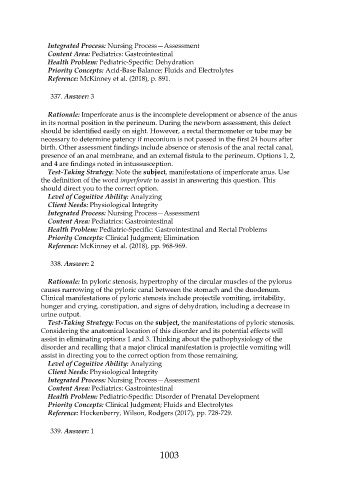Page 1003 - Saunders Comprehensive Review For NCLEX-RN
P. 1003
Integrated Process: Nursing Process—Assessment
Content Area: Pediatrics: Gastrointestinal
Health Problem: Pediatric-Specific: Dehydration
Priority Concepts: Acid-Base Balance; Fluids and Electrolytes
Reference: McKinney et al. (2018), p. 891.
337. Answer: 3
Rationale: Imperforate anus is the incomplete development or absence of the anus
in its normal position in the perineum. During the newborn assessment, this defect
should be identified easily on sight. However, a rectal thermometer or tube may be
necessary to determine patency if meconium is not passed in the first 24 hours after
birth. Other assessment findings include absence or stenosis of the anal rectal canal,
presence of an anal membrane, and an external fistula to the perineum. Options 1, 2,
and 4 are findings noted in intussusception.
Test-Taking Strategy: Note the subject, manifestations of imperforate anus. Use
the definition of the word imperforate to assist in answering this question. This
should direct you to the correct option.
Level of Cognitive Ability: Analyzing
Client Needs: Physiological Integrity
Integrated Process: Nursing Process—Assessment
Content Area: Pediatrics: Gastrointestinal
Health Problem: Pediatric-Specific: Gastrointestinal and Rectal Problems
Priority Concepts: Clinical Judgment; Elimination
Reference: McKinney et al. (2018), pp. 968-969.
338. Answer: 2
Rationale: In pyloric stenosis, hypertrophy of the circular muscles of the pylorus
causes narrowing of the pyloric canal between the stomach and the duodenum.
Clinical manifestations of pyloric stenosis include projectile vomiting, irritability,
hunger and crying, constipation, and signs of dehydration, including a decrease in
urine output.
Test-Taking Strategy: Focus on the subject, the manifestations of pyloric stenosis.
Considering the anatomical location of this disorder and its potential effects will
assist in eliminating options 1 and 3. Thinking about the pathophysiology of the
disorder and recalling that a major clinical manifestation is projectile vomiting will
assist in directing you to the correct option from those remaining.
Level of Cognitive Ability: Analyzing
Client Needs: Physiological Integrity
Integrated Process: Nursing Process—Assessment
Content Area: Pediatrics: Gastrointestinal
Health Problem: Pediatric-Specific: Disorder of Prenatal Development
Priority Concepts: Clinical Judgment; Fluids and Electrolytes
Reference: Hockenberry, Wilson, Rodgers (2017), pp. 728-729.
339. Answer: 1
1003

